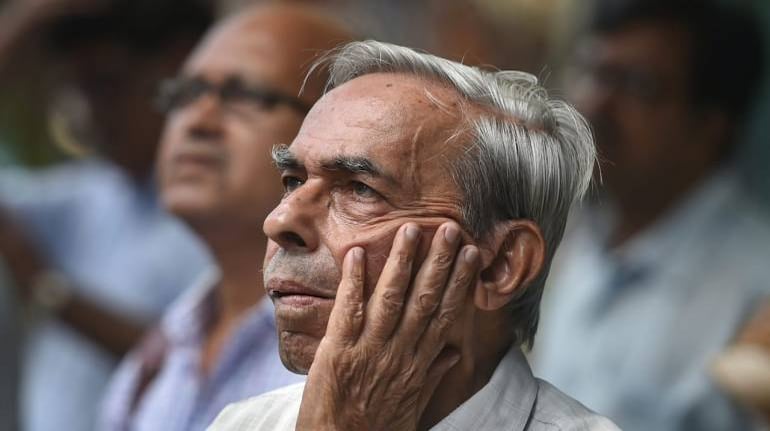



Indian benchmark equity indices continued to slide further on September 28, for the sixth straight session, dragged by banks, financials and metal companies amid weak global cues.
At 10:28am the Sensex was at 56,851.62, down 255.9 points or 0.45 percent, while the Nifty50 slipped 60.85 points or 0.36 percent to 16,946.55, below the psychological level of 17,000.
Blaming it on the bearish global trend, V K Vijayakumar, Chief Investment Strategist at Geojit Financial Services, Nasdaq is down 33.2 % from the peak and S&P 500 is down 24.3% from the peak. The Euro Stoxx 50 is down 24.3% from its peak. These are clear bearish signals from markets in the developed world. India is a distinct outlier with only 8.5 percent decline from the peak in Nifty. India can remain an outperformer supported by its strong fundamentals but India cannot remain immune to major global trends, he added.
Catch all the market action on our live blog
Here's a look at key factors fuelling the selloff:Global equity markets under pressureThe S&P 500 fell to its lowest level in almost two years on Tuesday on worries about super aggressive Federal Reserve policy tightening, trading under its June trough and leaving investors appraising how much further stocks would have to fall before stabilizing.
The S&P 500 touched a session low of 3,623.29, its lowest point on an intraday basis since November 30, 2020. A late rally helped push the index off its worst level of the day, but the index still closed lower for a sixth straight session as it lost 7.75 points, or 0.21%, to 3,647.29 .
Among the Asian names, Nikkei and Kospi tumbled over 2 percent each while SGX Nifty was down over a percent or 192 points at 16,846 level.
Rupee hits new record low, dollar record highThe rupee hit new low falling to 81.90 against the US dollar amid elevated US bond yields and firm US dollar. The dollar hit a fresh two-decade peak against a basket of currencies on Wednesday on the back of rising Treasury yields, while sterling languished near a record low on concerns over Britain's radical tax cuts to spur growth. The US dollar index hit a new high of 114.68 in Asia trade and was last up 0.42% at 114.62. Meanwhile, benchmark US 10-year Treasury yields rose to 4% for the first time since 2010, topping at 4.004%. The two-year yields stood at 4.2912%, according to a Reuters report.
Also read: What the RBI can do to rein in rupee’s depreciation
WTO chief expects downside revisions in global trade forecastThe head of the World Trade Organization told Reuters on Tuesday that she expects that global trade forecasts will be revised lower from the current 3 percent for 2022, citing the ongoing Russia-Ukraine war and related food and energy crises.
"We are in the middle of revising our forecasts now but it's not looking very promising. All the indicators are pointing to downside numbers," Director-General Ngozi Okonjo-Iweala told Reuters in an interview. "Grosso modo the outlook is looking gloomy," she said, without giving exact estimates.
The WTO already revised down its forecast for global trade growth this year to 3 percent from 4.7 percent in April. It projected 3.4 percent growth in 2023.
Technical Analysis"The Indian equity market started the day on a mild note amid mixed global cues, wherein the benchmark index seemed a bit nervous from the early trades and slipped into the negative terrain. However, the dip augured well for the bulls, and they made a modest recovery by the mid-session. But by the fag end, the correction triggered again resulting in a tentative closure with a mere loss of 0.05 percent and settled a tad above the 17000 mark," said Sameet Chavan, Chief Analyst-Technical and Derivatives, Angel One.
"We allude to the previous commentary on the benchmark index entering the cluster of key moving averages, i.e. 89-day EMA and 200-day SMA. Technically, the support of 17000-16800 shows their resilience as bulls retaliate from the same during intraday declines. As long as the mentioned zone is decisively held back by the bulls, one need not worry about further correction. Also, since the markets are extremely oversold, we advocate reducing short positions. Meanwhile, the intraday hurdles are seen around 17100 – 17200," he said.
Chavan believes, only a sustainable move beyond 17200 would trigger a sharp short covering rally in the market. Until then, the broad range (16800 – 17200) continues with a lot of indecisive swings on both sides, he said. Traders are advised to keep a close eye on global development as well. Any respite in oversold global peers would certainly uplift the overall market sentiments, he added.
Disclaimer: The views and investment tips expressed by experts on moneycontrol.com are their own, and not that of the website or its management. Moneycontrol.com advises users to check with certified experts before taking any investment decisions.Discover the latest Business News, Sensex, and Nifty updates. Obtain Personal Finance insights, tax queries, and expert opinions on Moneycontrol or download the Moneycontrol App to stay updated!
Find the best of Al News in one place, specially curated for you every weekend.
Stay on top of the latest tech trends and biggest startup news.